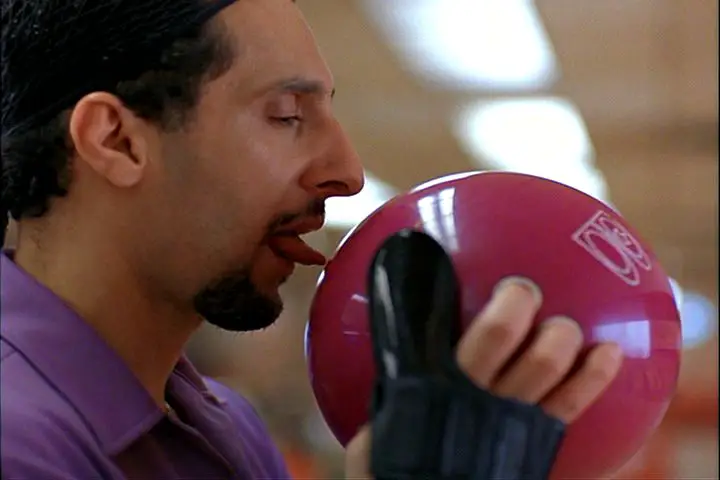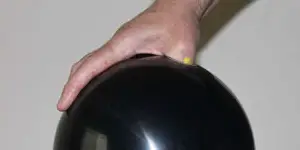
The vast majority of people in the US go bowling a couple times a year at most and when they do they don’t really have any idea what they are doing.
All they know is that they have to roll a big heavy ball down the lane and try to hit the pins.
Many people instinctively grab the ball with their thumb, middle, and ring fingers but most people with little prior knowledge about the sport tend to grab with their thumb, index, and middle fingers.
Not only is that wrong it isn’t going to make it easy to throw a high scoring game and it may just hurt your fingers a little bit as the ball will always want to roll off the side of your hand.
To safely hold a bowling ball you should always use your middle and ring finger and not your index finger!

If you are reading this then you may be surprised that there are lots of other things to keep in mind when it comes to holding a bowling ball properly, many of these factors I’ll go into in depth further down this page.
For the people that want it brief though I’ll start with a summary.
The Best Way to Hold a Bowling Ball for Either a Hook or Straight Ball
No matter if you are planning on throwing a hook or a straight ball you should do two things in order.
- First insert you middle and ring fingers into the finger holes.
- Second, you then insert your thumb in the thumb hole all the way to the webbing where your thumb connects to the rest of your hand.

When you set your feet on the approach as you get ready to make your delivery you should come to a full stop. With your fingers in the ball bring the ball to your lower chest with your hand under the ball cradling it. Your other hand should also be under the ball providing extra support.
From this position your thumb should be facing your body with the ball on top of your hand. Your fingers will be inside the finger holes on the other side of the ball.

That all is very basic and it all applies to virtually everybody who steps out onto a bowling lane… but, there are some supporting questions that must be addressed next.
Should You Put All of Your Fingers in the Holes or Just the Fingertips?
For the vast majority of casual bowlers who don’t know how to throw a hook, don’t want to throw a hook, or just don’t care to learn to throw a hook you should place your entire fingers in the holes and plan on making your arm swing with no rotation of your wrist during the delivery and release.
If your fingers are fully inserted in the ball with a fully inserted thumb and you twist your wrist or rotate your hand around the ball during the release it can be hard if not dangerous to get your fingers out of the ball when it comes time to let go.
Competitive bowlers and just-for-fun bowlers that try to hook the ball should never put their fingers into the holes beyond their first knuckle unless they really are experienced and know what they are doing.
What About the Thumb Hole? Do You Have to Put Your Thumb in the Thumb Hole?
Conventional wisdom says yes but modern bowling says maybe not.
If you want to bowl with the most control and the with the easiest form of delivery then yes, you should put your thumb into the thumb hole but for people who are learning to hook the ball many will remove their thumb from the hole and either palm the ball or use their second hand to stabilize it on their palm through the delivery.
When a ball fits your hand just right you should be able to put your thumb in the ball and pick it up without the aid of your other fingers or hand. This is why it should be very easy for a person to swing the ball and release it with the entire thumb inserted into the hole.
For a straight ball bowler the thumb will be on top of the ball during the release and it will exit the ball first followed by the trailing fingers which come up the backside of the bowling ball.
Throwing a Curve Without the Thumb & Two-Handed Bowling
For any bowler that throws any form of a hook or curve the thumb will also be the first finger to exit the ball except the thumb will not be on the top of the ball when it is released. It will either be on the left side of the ball if you are delivering a suitcase style delivery or the thumb will be release on the right side of the ball if you are throwing a standard hook.
For bowlers that choose to hook the ball without using the thumb then you will have to stabilize (hold) the ball by placing it directly on top of your palm throughout the entire arm swing.
Many no-thumb bowlers that palm the ball find success using a single hand to support the ball through the swing but since the late 90’s and early 2000’s many no-thumb bowlers have begun supporting the ball on their palm with their opposite hand throughout the arm swing.
The two-handed approach is something I started using back in 1994 and I have refined it over the years.
As we are well into the 20-teens some two-handed bowlers have even begun inserting their thumb back into the ball while still using their second hand to support the palmed ball.
You’ll find that palming the ball will give your ball more rotations per minute (RPMs) but without the second hand or thumb inserted the speed will usually be lacking and the consistency of the release point will be hard to master.
Why Do My Fingers Always Get Stuck in the Ball?
So everything I’ve said thus far is just basic information that the majority of bowlers follow to hold the ball and stay safe and avoid injury.
Many bowlers in fact hold the ball in different ways, some of which are not the proper way to do it!
Even me, I don’t hold the ball the correct way!
I hold the ball with a finger tip palm grip, a second supporting hand, and I only insert my thumb tip in the ball because adding my full thumb always resulted in my ball sticking to my thumb.
I started 2-handed bowling back in the 90’s, well before the style was popularized and probably 15 years before any coach started teaching the method.
For me I pulled my thumb out a bit to avoid sticking and it was fine because my second hand was there to support my backswing.
For conventional bowlers who put their thumb all the way into the ball the thumb sticking typically is caused for a few main reasons.
When the thumb hole is too big for your thumb it can cause a bowler to overly grip the thumb hole in the arm swing which can make it hard to release it at exactly the correct time for a smooth exit by the thumb.
If you are consistently having your thumb sticking in your ball then you may want to see if your thumb hole is actually too big!
The other end of the spectrum is just what you might expect and it’s probably what the novice bowler always thinks from the beginning. If the thumb hole is to small for your thumb then obviously it may be hard for it to exit the thumb hole smoothly as it should.
There are a couple other situations that might result in a thumb that sticks that may not be so obvious.
You may have a thumb that swells up from time to time making your thumb hole fit properly for a while and then fit too tight due to a swelling thumb.
If this is a common problem for you then the solution is typically the interchangeable thumb slug that your local proshop professional can help you install. You can usually have a few thumb sizes that you can insert in your ball to make a perfect fit no matter how big or small your thumb is at any given time.
The last main reason why a thumb sticks in the ball is because it is not at the correct angle for release. Imagine putting a stick in a pipe and then trying to pull the stick out sideways instead of straight out. Usually the stick will bend or break on the way out even if it is a lot skinnier that the opening of the pipe.
Bringing the analogy back to your hand your thumb will not exit the ball comfortably even if the thumb hole fits perfectly if you try to pull the thumb out of the hole incorrectly.
This usually happens when beginning bowlers attempt to throw a hook for the first time or begin practicing a curve and release the ball poorly.
It also happens when recreational bowlers release the ball backwards with the fingers leading the thumb. If the fingers are the first to release the ball tends to spin backwards relative to its forward momentum and the thumb won’t let it spin backwards because it is still fully inserted.
When this happens the thumb takes a lot of pressure, it usually sticks and it can be painful to the bowler. Frequently the bowler doesn’t even realize why the release hurt and gets frustrated with bowling because of it.
A beginning bowler that does this should learn a bit more about how to bowl properly even if he or she doesn’t want to learn to throw a hook and score big games.
